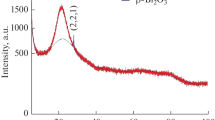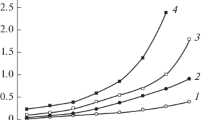Abstract
Bismuth-containing composite materials based on high-silica porous glasses (PGs) of various types are prepared. Their structural parameters and electrokinetic potential in 10–2 М KNO3 solutions in the pH range 1.5–8.5 are studied. The results are compared with the analogous properties of matrices not modified with bismuth oxide, as well as the pH dependence of the zeta-potential for SiO2 particles and the sols of synthesized and industrial bismuth(III) oxide. It is determined that modification of larger-pore particles not containing secondary silica with bismuth(III) oxide results in the deviation of the form of the ζ–рН dependences from those intrinsic for high-silica PG and SiO2 particles.




Similar content being viewed by others
REFERENCES
Antropova, T.V., Inorganic functional glass-forming materials based on liquating alkaline borosilicate systems, in IKhS RAN-80 let. Sovremennye problemy neorganicheskoi khimii (Inst. Silicate Chem. RAS 80th Anniversary, Modern Problems of Inorganic Chemistry), Shevchenko, V.Ya., Ed., St. Petersburg: Art.-Ekspress, 2016, pp. 117–137.
Inayat, A., Reinhardt, B., Herwig, J., Küster, C., Uhlig, H., Krenkel, S., Raedlein, E., and Enke, D., Recent advances in the synthesis of hierarchically porous silica materials on the basis of porous glasses, New J. Chem., 2016, vol. 40, no. 5, pp. 4095–4114.
Ermakova, L.E., Volkova, A.V., Antropova, T.V., Orbeli, N.O., and Anfimova, I.N., Electrokinetic characteristics of initial porous glasses and those modified with titanium- and aluminum-oxide particles, Colloid J., 2017, vol. 79, no. 6, pp. 762–772.
Chamaya, E.V., Tien, C., Wur, C.S., and Kumzerov, Yu.A., Superconductivity of gallium in porous glass, J. Phys. C: Solid State Phys., 1996, vol. 269, pp. 313–324.
Golosovsky, I.V., Mirebeau, I., Fauthc, F., Kurdyukov, D.A., and Kumzerov, Yu.A., Magnetic structure of hematite nanostructured in a porous glass, Solid State Commun., 2007, vol. 141, pp. 178–182.
Yang, K., Zheng, Sh., Jiang, X., Fan, Sh., and Chen, D.-P., Luminescence and scintillation of high silica glass containing SnO, Mater. Lett., 2017, vol. 204, pp. 5–7.
Sidorov, A.I., Ngo Dui Tung, Ngo Van Wu, Antropova, T.V., and Nashchekin, A.V., Optical properties of nanocomposites based on zinc and tin sulfides in nanoporous silicate glass, Opt. Spectrosc., 2019, vol. 127, no. 5, pp. 914–918.
Sidorov, A.I., Ngo Dui Tung, Ngo, Van Wu, N., Antropova, T.V., Nashchekin, A.V., Castro, R., and Anfimova, I.I., Optical and dielectric properties of nanocomposites based on zinc and tin oxides in nanoporous glass, Glass Phys. Chem., 2019, vol. 45, no. 6, pp. 421–428.
Antropova, T., Girsova, M., Anfimova, I., Drozdova, I., Polyakova, I., and Vedishcheva, N., Structure and spectral properties of the photochromic quartz-like glasses activated by silver halides, J. Non-Cryst. Solids, 2014, vol. 401, pp. 139–141.
Antropova, T.V., Girsova, M.A., Anfimova, I.N., and Drozdova, I.A., Spectral properties of the high-silica porous glasses doped by silver halides, J. Lumin., 2018, vol. 193, pp. 29–33.
Cizman, A., Antropova, T., Anfimova, I., Drozdova, I., Rysiakiewicz-Pasek, E., Radoewska, E.B., and Poprawski, R., Size-driven ferroelectric-paraelectric phase transition in TGS nanocomposites, J. Nanopart. Res., 2013, vol. 15, no. 8, 1807. https://doi.org/10.1007/s11051-013-1807-y
Cizman, A., Marciniszyn, T., Rysiakiewicz-Pasek, E., Sieradzki, A., Antropova, T.V., and Poprawski, R., Size effects in KDP-porous glass ferroelectric nanocomposites, Phase Trans., 2013, vol. 86, no. 9, pp. 910–916.
Rysiakiewicz-Pasek, E., Cizman, A., Drozdova, I., Polyakova, I., and Antropova, T., Synthesis, structure and properties of mixed KNO3–NaNO3 embedded into nanoporous silica glass, Composites, Part B, 2016, vol. 91, pp. 291–295.
Cizman, A., Rogacki, K., Rysiakiewicz-Pasek, E., Antropova, T., Pshenko, O., and Poprawski, R., Magnetic properties of novel magnetic porous glass-based multiferroic nanocomposites, J. Alloys Compd., 2015, vol. 649, pp. 447–452.
Ermakova, L.E., Kuznetsova, A.S., Volkova, A.V., and Antropova, T.V., Structural and electrosurface properties of iron-containing nanoporous glasses in KNO3 solutions, Colloids Surf., A, 2019, vol. 576, pp. 91–102.
Girsova, M.A., Firstov, S.V., and Antropova, T.V., The influence of the bismuth concentration and heat treatment on the properties of bismuth-containing high-silica glass. II. Luminescence properties, Glass Phys. Chem., 2019, vol. 45, no. 2, pp. 98–103.
Dianov, E.M., Yang, L., Iskhakova, L.D., Vel’miskin, V.V., Plastinin, E.A., Milovich, F.O., Mashinskii, V.M., and Firstov, S.V., Use of nanoporous glass for the fabrication of heavily bismuth-doped active optical fibres, Quantum Electron., 2018, vol. 48, no. 7, pp. 658–661.
Antropova, T.V., Girsova, M.A., Anfimova, I.N., Golovina, G.F., Kurilenko, L.N., and Firstov, S.V., RF Patent 2605711, Byull. Izobret., 2016, no. 34.
Antropova, T.V., Girsova, M.A., Anfimova, I.N., and Drozdova, I.A., Spectral properties of the high-silica porous glasses doped by silver halides, J. Lumin., 2018, vol. 193, pp. 29–33.
Zhdanov, S.P., Porous glasses and their structure, Wiss. Z. Friedrich-Schiller-Univ.,Jena:Naturwiss. Reihe, 1987, vol. 36, pp. 817–830.
Ermakova, L.E., Antropova, T.V., Volkova, A.V., Kuznetsova, A.S., Grinkevich, E.A., and Anfimova, I.N., Structural parameters of membranes from porous glass in aqueous solutions of electrolytes, containing singly-charged (Na+, K+) and triple-charged (Fe3+) cations, Glass Phys. Chem., 2018, vol. 44, no. 4, pp. 269–278.
Antropova, T., Girsova, M., Anfimova, I., Drozdova, I., Polyakova, I., and Vedishcheva, N., Structure and spectral properties of the photochromic quartz-like glasses activated by silver halides, J. Non-Cryst. Solids, 2014, vol. 401, pp. 139–141.
Kreisberg, V.A. and Antropova, T.V., Changing the relation between micro- and mesoporosity in porous glasses: The effect of different factors, Microporous Mesoporous Mater., 2014, vol. 190, no. 1, pp. 128–138.
Kuznetsova, A.S., Volkova, A.V., Ermakova, L.E., and Antropova, T.V., Iron(III) ion adsorption on macroporous glass, Glass Phys. Chem., 2018, vol. 44, no. 1, pp. 41–46.
Girsova, M.A., Golovina, G.F., Anfimova, I.N., and Kurilenko, L.N., Properties of bismuth-containing high-silica glass depending on the bismuth concentration and heat treatment. I. Spectral-optical properties, Glass Phys. Chem., 2018, vol. 44, no. 5, pp. 381–387.
Sidorova, M.P., Zastrow, H., Ermakova, L.E., Bogdanova, N.F., and Smirnov, V.M., Synthesis of titanium–oxygen layers on silicon oxide monodisperse particles and comparison between the electrosurface characteristics of the initial and modified particles, Colloid J., 1999, vol. 61, pp. 104–109.
ACKNOWLEDGMENTS
The authors thank M.A. Girsova for her help in the thermal treatment of the composites and I.G. Polyakova for the X-ray phase analysis of bismuth oxides. The studies were carried out using the equipment of the Resource Centers of the Research Park of St. Petersburg State University “Nanotechnologies” and “Methods of analysis of the composition of a substance.”
Funding
The work was supported by the Russian Foundation for Basic Research (project no. 18-03-01206). The samples of two-phase glass and PG were fabricated as part of a state task (0097-2019-0015) of the Grebenshchikov Institute of Silicate Chemistry of the Russian Academy of Sciences.
Author information
Authors and Affiliations
Corresponding author
Ethics declarations
The authors declare that they have no conflict of interest.
Additional information
Translated by A. Muravev
Rights and permissions
About this article
Cite this article
Kuznetsova, A.S., Ermakova, L.E., Anfimova, I.N. et al. Electrokinetic Characteristics of Bismuth-Containing Materials Based on Porous Glasses. Glass Phys Chem 46, 290–297 (2020). https://doi.org/10.1134/S1087659620030086
Received:
Revised:
Accepted:
Published:
Issue Date:
DOI: https://doi.org/10.1134/S1087659620030086




